Excerpts from Jim Conrad's
Naturalist Newsletter
Entry from field notes dated June 29, 2023, taken along one-lane gravel road in valley between Puerto del Zenthé and Chavarrías in mountainous area with a maze of roads too complex to say how to get there; in general it's in the mountains of east-central Querétaro state, municipality of Cadereyta de Montes, 12 straight-line kms due east of Vizarrón de Montes but much farther by twisting roads; juniper-scrub forest; limestone bedrock; elevation ~2840m (~9300 ft), Querétaro, MÉXICO, (N20.84604°, W99.60655°)
MEXICAN HONEYSUCKLE

Beside the road, the above flowers grew on a semi-woody, vine-like stem entangled among juniper branches. With such a cluster of red corollas composed of long tubes topped with five short, flaring petals, and the flower cluster subtended by a broad collar, plus the stems being somewhat viny, what could it be but some kind of honeysuckle, genus Lonicera? About 150 honeysuckle species are recognized. They belong to the Honeysuckle Family, the Caprifoliaceae, which embraces species mostly adapted to temperate zones in eastern Asia and eastern North America. These central Mexican uplands are temperate in nature, so a honeysuckle species isn't a surprise here.
In fact, the Flora del Bajío treatment of the Honeysuckle Family, published in 2000, documents three honeysuckle species for our upland central Mexican region known as the Bajío, and surrounding areas. Of those three species, if your honeysuckle's blossoms form clusters of more than two, and the corolla color is red, orangish or yellow, and hairy, the Flora says you have Lonicera pilosa, with the species distributed in uplands throughout Mexico into Guatemala.
The species was further analyzed in a later-published, 2016 work by José Á. Villarreal-Quintanilla and others entitled "El complejo Lonicera pilosa (Kunth) Spreng. (Caprifoliaceae)." That study found that Lonicera pilosa manifests as two well defined varieties, the variety glabra lacking hairs on its corolla inhabiting the Western Sierra Madres, and our hairy-corolla variety, LONICERA PILOSA var. PILOSA, in the Eastern Sierra Madres and farther south. Here's what our plant looks like draped on the junipers:

At least sometimes northern garden supply businesses call Lonicera pilosa Mexican Honeysuckle.
The Flora del Bajío describes this species as a twining shrub with a flexible stem, up to 6m long 20ft.
In Mexico Lonicera pilosa has a long history of traditional significance. A 2023 Mexican government press release announcing an exhibition in Mexico City says that the ancient Aztecs adorned sacrificial offerings to their sun and war god Huitzilopochtli with this species' flowers and leaves, the reddish flowers and green leaves evoking the fiery, solar nature of the god. This association of flower color with heat probably explains the Aztecs' medicinal use of the plant for fever, burns, and kidney pain.
However, today their main attraction seems to be as an ornamental. The 2007 study by Eduardo Estrada and others entitled "Ethnobotany in the Cumbres de Monterrey National Park, Nuevo León, México" lists Lonicera pilosa among the most commonly cultivated ornamental plants of northern Mexico's Cumbres de Monterrey National Park. The online Annie's Annuals retail plant nursery describes the species as loved by hummingbirds and "... a gem for a trellis, obelisk or growing amid taller shrubs." Further, its "pretty darn tough," with brief solid freezes not being a problem.